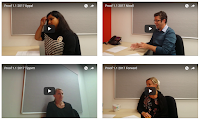We provided a task that looked at two narratives behind the formation of Kā Tiritiri o te Moana (the Southern Alps). Kā Tiritiri o te Moana are at the boundary of our place, the Selwyn District. They are a major part of our place when we look further out to Waitaha (Canterbury), Te Waipounanu/Te Waka o Aoraki (the South Island), and Aotearoa (New Zealand).
Ākonga did a very good job of summarising the two narratives into sequences that made it easy for the reader to see the flow of the key events. However, the evaluation of the importance of the two very different narratives was lost on most of them. In many cases, it was a bridge too far, and nothing was written (although time could have been a factor in this as well).
For many, they were happy to express an opinion about which was more relevant now - still fresh in many of their minds are the earthquakes we experience, that can be explained by the Plate Tectonic Theory but ākonga could not immediately see any link to the Ngāi Tahu narrative for these.
Despite ākonga generally not taking this as "deep" as I would have liked, I really enjoyed guiding them through the learning of these two narratives. I enjoyed the conversations and had to remind myself that these were only 12 and 13 year old students. I am enjoying giving feedback and advice when reviewing their responses. I always feel like ākonga have been offered a good learning opportunity when I enjoy reading and marking their work from the task.
When I reflect on this session, my main point to change would be the time allowance. We have 100 minute learning blocks, and this could easily have taken an entire block, particularly with the amazing human resources we have - 3-4 kaiako for 60 ākonga per block.
I would also consider altering the bullet-points used to guide them with their evaluation. I think challenging them about which story had more meaning for them, personally, might have led to even more interesting responses. Still, not too bad for their second piece of work in Connected Learning.
Despite ākonga generally not taking this as "deep" as I would have liked, I really enjoyed guiding them through the learning of these two narratives. I enjoyed the conversations and had to remind myself that these were only 12 and 13 year old students. I am enjoying giving feedback and advice when reviewing their responses. I always feel like ākonga have been offered a good learning opportunity when I enjoy reading and marking their work from the task.
When I reflect on this session, my main point to change would be the time allowance. We have 100 minute learning blocks, and this could easily have taken an entire block, particularly with the amazing human resources we have - 3-4 kaiako for 60 ākonga per block.
I would also consider altering the bullet-points used to guide them with their evaluation. I think challenging them about which story had more meaning for them, personally, might have led to even more interesting responses. Still, not too bad for their second piece of work in Connected Learning.





